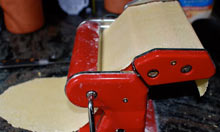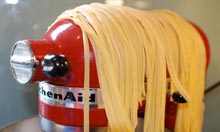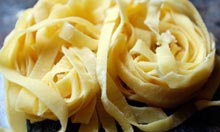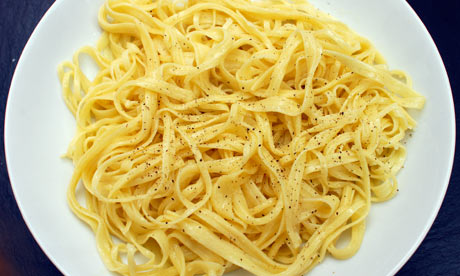How to make perfect pasta
Commiserating with a friend recently over a break-up, we ran dutifully through her ex's faults – his insensitivity, his collection of three-quarter length trousers – and then, becoming increasingly worked up, she dropped a bombshell. "He didn't like pasta." There was a silence, followed by an explosion of incredulity. How had it lasted so long, we wondered? A person who could digest wheat, and yet didn't appreciate pasta – well, that was clearly never going to work.
Garibaldi relied on the power of macaroni to unite Italy, Sophia Loren famously claimed she owed her voluptuous figure to spaghetti, and chef Giorgio Locatelli reckons every Italian is two-thirds pasta. Despite a lingering fondness for "hoops", even Britain has embraced proper pasta in recent years. These days we know our pappardelle from our penne, and we're beginning to get the concept of different shapes for different sauces, although we're still more likely to reach for whatever's in the cupboard come Sunday evening, and if it's bow ties and pesto, then so be it. But the idea of making our own is still entirely foreign to most of the nation.
Dried pasta and fresh egg pasta are two different beasts. You wouldn't use a waxy potato for baking, for the same reason an Italian wouldn't serve dried spaghetti with a game ragu – it doesn't work. Fresh egg pasta gets its 'bite' from the egg proteins, and is traditionally served with the butter, cream and rich meat dishes of the north, while dried pasta generally pairs better with the olive oil and tomato recipes of the south.
Dried pasta and fresh egg pasta are two different beasts. You wouldn't use a waxy potato for baking, for the same reason an Italian wouldn't serve dried spaghetti with a game ragu – it doesn't work. Fresh egg pasta gets its 'bite' from the egg proteins, and is traditionally served with the butter, cream and rich meat dishes of the north, while dried pasta generally pairs better with the olive oil and tomato recipes of the south.
Good dry pasta is widely available these days, as long as you're prepared to spend a bit more than you would on the budget varieties, but, with a little practice, you can produce your own fresh stuff which will knock the socks off anything from the supermarket – a product which, as Locatelli says, has "real personality". As Giulana Lo Conte, who has been making her own pasta since she was six, and whose family business supplies Carluccio's, explains to me, it's "a skill you will keep with you for life".
Basic recipe
Before attending Signora Lo Conte's masterclass, I've always relied on the recipe in the Silver Spoon, the English version of Italy's most famous cookbook, for pasta. It makes it seem a very simple affair – 200g plain flour ('00' for preference, as the fine texture gives it a silky texture) is mixed with a pinch of salt, and then 2 lightly beaten eggs.
The resulting dough is kneaded for about 10 minutes, allowed to rest, and then rolled out and passed through a pasta machine. The Signora spurns all machinery, preferring an enormous rolling pin, but admits that, for the amateur (ie British) pasta maker, such things "might" have their uses. I cut the finished sheets into tagliatelle, and cook them for a couple of minutes in a pan of boiling, heavily salted water, and then drain and sample. It's good: firm, with a silky texture. I'd be happy stopping here, but this simple recipe is just the tip of the iceberg.
Semolina

Signora Lo Conte uses a mixture of flours for her pasta: 160g of tipo 00 to 240g of semolina (coarsely ground hard durum wheat flour), and 5 eggs. She explains that the proportions tend to depend on where the family comes from, with the semolina content rising as one travels south, but it doesn't matter too much as long as you include some semolina to "give the pasta its bite".
Although delicious in the ravioli we make together, I find this ratio slightly grainy in tagliatelle, so I switch to half and half, as recommended by Ursula Ferrigno in her Complete Italian Cookery Course. This is more subtly textured, while retaining that interesting roughness which helps a sauce to adhere, something lacking in the recipe in the River Café Classic Italian Cookbook, which uses semolina flour to dust the 100% 00 pasta. I'm still not entirely happy though – I'm a fan of the silky smoothness of fresh pasta, so I compromise with one third semolina to two thirds 00 flour.
Eggs

While those in the south use semolina to give their pasta body, the north prefers eggs, and lots of them. Ruth Rogers and the late Rose Gray use 4 large whole eggs, and 6 yolks to 500g of flour. Despite adding the liquid very gradually, I still end up with a rather soft, squidgy dough, and the end result is tasty, but heavy in comparison to my previous efforts. This would be one to serve very simply, with a little butter, cheese and black pepper – it's a meal on its own.
Giorgio Locatelli, in his superb Made in Italy, uses 3 large eggs, and 2 large yolks to 500g flour, which gives a rich, but rather lighter result. According to the Michelin-starred chef, who hails from the Italian lakes, the number of eggs also varies from region to region, and the more you add, the "crispier" the pasta becomes – he recalls a dough he made for Joël Robuchon, which used 52 egg yolks to a kilo of flour. It was, apparently, "incredibly snappy".
Olive oil

Angela Hartnett, meanwhile, uses 4 eggs to 400g flour, and adds a tablespoon of olive oil, an ingredient also favoured by Marcus Wareing and Ursula Ferrigno. It makes the dough silkier and slightly easier to work with, but, as the oil used should be 'light' rather than assertive, I'm unable to taste it in the cooked pasta. I can't help feeling that, if I'm going to be using the pasta in traditional, northern, butter-based dishes however, this quintessentially southern flavour is incongruous, however subtle it might be.
Method
Marcus Wareing's recipe, from his How to Cook the Perfect … book, gives directions for making the dough in a food processor, and then kneading it by hand. Although I can see this might well be useful for large quantities, it's easier to mix three ingredients together on the work surface, and also allows one to judge more accurately how much liquid to add – as Signora Lo Conte tells me, it's impossible to give an exact recipe, as the amount the flour will absorb depends on any number of environmental factors.

Rather than simply passing the dough through a pasta machine, both Angela Hartnett and Giorgio Locatelli fold it back in on itself halfway through the process, and repeat to give a more evenly rolled finish. This takes longer, and I have to work quickly to avoid the pasta drying out, but the texture seems more uniform, and the pasta stronger and more elastic, than with a simpler, but less thorough method.
When it comes to cooking, a rolling boil, and a generous amount of salt (Lo Conte adds a large handful without apology) is standard-issue advice (although some interesting experiments have been done in the US which suggests that neither boiling water, nor a large pan, is necessary for dried pasta), but adding olive oil to the water is unnecessary; as long as you don't add too much pasta at a time, and give it a stir to get it going, it shouldn't stick together. In fact, I discover, the oil makes it more difficult for any sauce to cling to the pasta on the plate.
Fresh pasta is both easy, and remarkably satisfying to make – and the perfect recipe is very much a matter of personal preference, and regional loyalty. However, good quality ingredients – fine durum wheat flour and rich, well-flavoured eggs – and the time to work to a smooth, silky finish, are essential.
Felicity's perfect pasta

Makes around 600g (enough for 4 as a main course)
340g 00 flour
160g semolina flour
Large pinch of salt
3 large eggs and 2 or 3 egg yolks, at room temperature, lightly beaten (if the mixture doesn't come together with 2 yolks, add a third)
160g semolina flour
Large pinch of salt
3 large eggs and 2 or 3 egg yolks, at room temperature, lightly beaten (if the mixture doesn't come together with 2 yolks, add a third)
1. Mix the flours and the salt and shape into a volcano on the work surface, or a wooden board. Make a well in the middle, and pour in two thirds of the eggs.
2. Using your fingertips in a circular motion, gradually stir in the flour until you have a dough you can bring together in a ball, adding more egg if necessary. Knead for about 10 minutes until it is smooth, and springs back when poked, wetting your hands with cold water if necessary.
3. Divide the dough in two and wrap in a damp cloth. Allow to rest for about an hour in a cool place.
4. Roll out the first ball of dough on a lightly floured surface until it is about 1cm thick and will go through the widest setting of your pasta machine comfortably. Put it through each setting twice, then fold it back in on itself, and repeat the process, cutting it in half when it becomes too long to handle. Store the other half under a damp cloth until you're ready to continue working on it.
5. When the pasta has a good sheen to it, and is thin enough for your liking – pappardelle and tagliatelle should be cut on the second narrowest gauge, filled pastas such as ravioli on the narrowest – cut using a knife, or the cutter on your pasta machine. Curl into portion-sized nests and leave on a floured surface, under a damp cloth, while you repeat with the rest of the dough.
6. Bring a large pan of well-salted water to the boil, add the pasta, in batches if necessary, and cook for a couple of minutes, stirring occasionally to keep it moving. Serve immediately.
What's your favourite pasta recipe – and do you use a machine, or are they strictly for Anglo Saxon wimps? And can anyone tell me the best brand of dried pasta to keep in the cupboard?
ليست هناك تعليقات:
إرسال تعليق